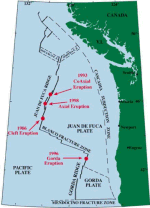| . | History of hydrothermal plume studies at PMEL |
| . |
Systematic annual surveys of hydrothermal plumes over the Juan de Fuca Ridge began in 1984. In 1986, when a very impressive, large, nearly circular plume ("megaplume") was discovered over the northern portion of the Cleft segment on the Juan de Fuca Ridge, the impact of episodic volcanic events on hydrothermal activity was realized. As a result of this discovery, the EOI Program began to emphasize the importance of long-term monitoring the hydrothermal environment at this site. This includes annual CTD/chemical surveys, acoustic monitoring to listen for seismic activity along the Juan de Fuca and Gorda Ridges, moored sensors to provide time series records of temperature, optical properties and currents in the water overlying the ridge, and preparedness for rapid response in the event seismic activity indicates a volcanic eruption is in progress. We have been increasingly better prepared to respond to and observe the effects of each event between 1986 and 1998, starting with the fortuitous observation of an event plume (Cleft Segment, 1986) to having a full set of moored instruments monitoring the seafloor and overlying water during the entire period prior to, during and for some time after an event (Axial Volcano, 1998). As a result, we've been able to develop the concept of and begin to implement the New Millenium Observatory (NeMO) in order to examine the relationships between volcanic events and the chemistry and distribution of hydrothermal vents, particularly in regard to their influence on the microbial biosphere that depend on them below the seafloor. What we've been learning about
hydrothermal systems at our nearby off-shore laboratory has had significance
to the broader context of global hydrothermal processes as well, so another
goal of this program has been to assess the contribution of hydrothermal
discharge to global chemical and thermal budgets. Collaborations with
non-NOAA researchers, and the development of innovative
instruments to facilitate these collaborations has been an important
element for pursuing this research efficiently. |
. | |||
| Hydrothermal
Plumes: What are hydrothermal plumes? | Why Study? | History | Study Areas | Methods |
|||||

